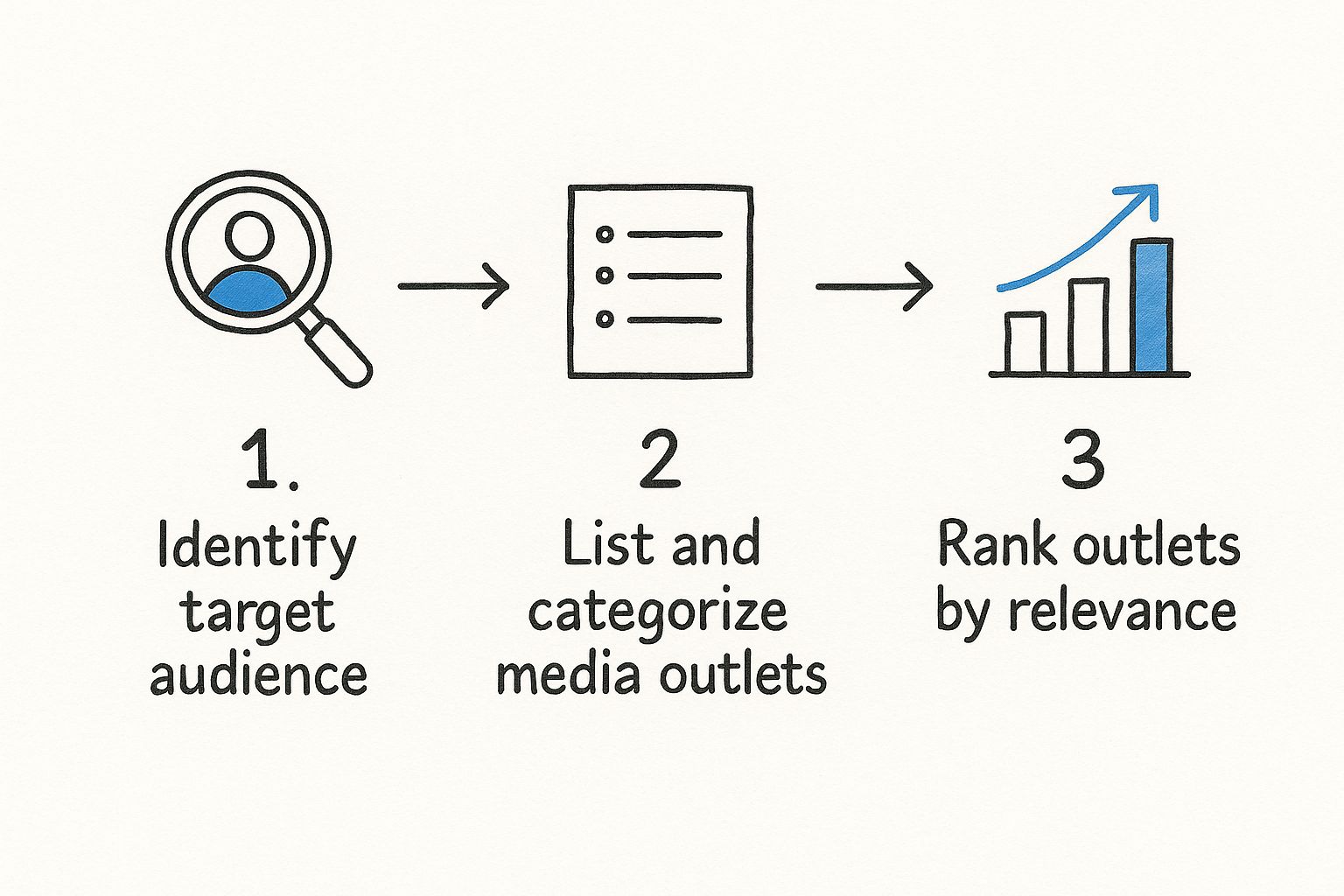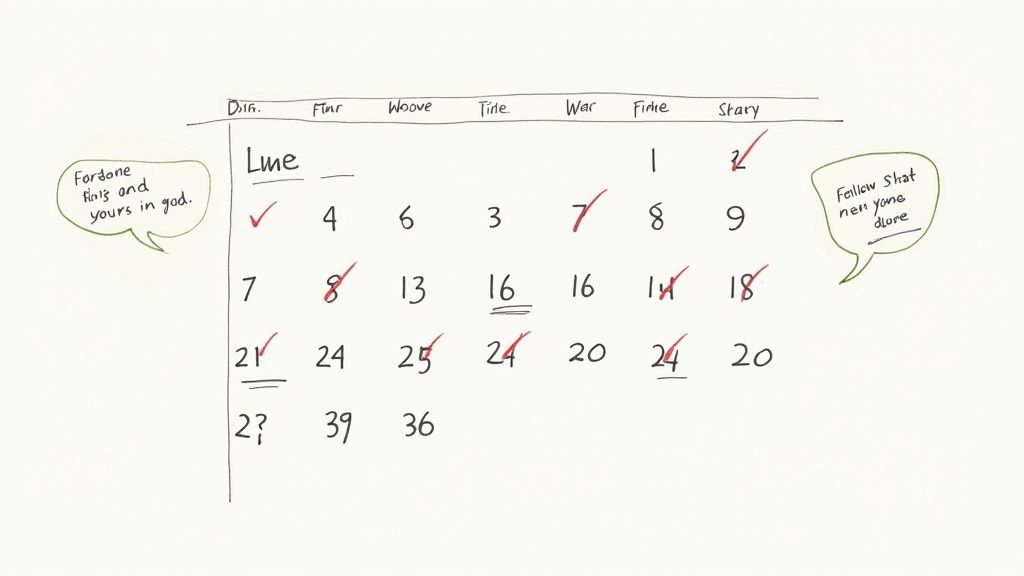Pitch to Media Successfully: Master Your Press Outreach
October 6, 2025

If you want to get your story in front of the right audience, a generic email blast just won't cut it. The real secret to landing media coverage lies in a smart, personalized approach—one that focuses on building real relationships with journalists who actually care about your niche.
Why a Thoughtful Media Pitch is Still Your Best Bet

We live in a world saturated with paid ads and sponsored content. Because of this, a single feature in a trusted publication—what we call earned media—can do more for your credibility than an entire ad spend. When an established voice tells your story, it acts as a powerful third-party endorsement that you simply can't buy.
That said, getting a journalist’s attention has never been harder. Their inboxes are flooded with hundreds of emails every single day. Most are generic, self-serving, and completely miss the mark. This is exactly why a pitch that is genuinely thoughtful and personal isn't just a nice touch anymore; it's absolutely essential.
The Real Impact of Earned Media
When your pitch hits the mark, it opens the door to earned media, and the benefits go way beyond a quick mention. These advantages build on each other, creating a solid reputational foundation for your brand.
- Builds Real Authority: Getting featured in respected publications instantly positions you as a go-to expert.
- Expands Your Reach: Your story connects with a fresh, engaged audience you likely couldn't have reached on your own.
- Drives Quality Traffic: Media mentions usually come with backlinks, sending relevant, interested readers straight to your website.
A great media pitch is fundamentally an act of service. You're not asking for a favor; you're offering a journalist a compelling, well-researched story that their audience will value.
Keeping Up With a Changing Media World
To really understand what a journalist needs, you have to appreciate the world they work in. The media environment is constantly in flux. Just as advertisers have to weigh the differences between digital and traditional channels, we have to recognize that a one-size-fits-all PR strategy is doomed to fail.
A pitch that grabs the attention of a fast-moving tech blogger will look completely different from one sent to a seasoned print journalist at a legacy publication. Understanding these subtle differences is how you unlock the true value of earned media and make sure your outreach actually gets results.
Laying the Groundwork for a Winning Pitch
A powerful media pitch is never a shot in the dark. It's the result of smart, deliberate preparation. Honestly, the most critical work happens long before you even think about drafting an email. This initial research is what separates a pitch that gets instantly deleted from one that turns into a feature story.
Success starts with knowing exactly who you're trying to reach. Forget chasing big, flashy publication names for a moment and focus on the journalists and outlets that genuinely speak to your target audience. Where do they get their news? Answering that simple question is the first real step toward finding the right home for your story.
This whole process is about narrowing your focus from a broad audience to a specific, prioritized list of real people.

As you can see, it’s a funnel. You start with a wide pool and methodically drill down until you have a concrete outreach plan with the most relevant contacts at the top.
Finding the Right Journalists
Once you have a shortlist of target publications, your real mission begins: finding the specific individuals who cover your industry or topic. Sending a pitch to a generic "tips@" or "editor@" email address is a recipe for failure. Your pitch needs a name and a face attached to it.
Platforms like LinkedIn and X (what we all still call Twitter) are goldmines for this. A quick search for job titles like "tech reporter," "health editor," or "SaaS journalist" along with the publication's name will get you started. Pay close attention to what these reporters are posting and sharing—it’s a live feed of their professional interests and what’s on their radar.
Analyzing Their Work and Beat
Okay, you've found a journalist. But that's only half the battle. To craft a pitch they'll actually open, you have to understand their specific beat—the area or topic they’re assigned to cover. This is non-negotiable.
Before you do anything else, go read their last five articles. What angles do they typically take? Are they into data-driven stories, personal profiles, or broad industry trend analyses? This is your chance to get inside their head.
Don’t just pitch your story; pitch your story for their audience. Show the journalist you've done your homework and understand what their readers find valuable. This simple shift in perspective can make all the difference.
This deep dive is what allows you to tailor your story idea so it fits perfectly with their style and needs. It's a crowded field out there. With global media usage averaging a staggering 57.2 hours per week, journalists are fighting tooth and nail for reader attention. As digital media growth slows and traditional channels decline, reporters are under more pressure than ever to find stories that truly connect. You can see more on the numbers shaping global media engagement on MarketingDive.com.
I can't stress this research phase enough. I've seen countless great stories get ignored because the pitch was sent to the wrong person. Before you hit send, run through this checklist.
Journalist Research Checklist
This checklist covers the essential steps to take before you ever write a single word of your pitch. Skipping these will almost guarantee your email ends up in the trash.
| Research Step | What to Look For | Why It Matters |
|---|---|---|
| Beat Analysis | The specific topics they consistently cover (e.g., AI in healthcare, startup funding). | Ensures your story is relevant to their job and not an immediate "delete." |
| Recent Articles | Themes, formats (interviews, listicles), and tone of their last 5-10 articles. | Helps you frame your pitch in a style they are familiar with and likely to use. |
| Audience Focus | Who are they writing for? (e.g., C-level executives, developers, consumers). | Your story must provide value to their readers, not just promote your brand. |
| Social Media Activity | What are they sharing, commenting on, or asking for on platforms like X or LinkedIn? | Gives you insight into their current interests and potential story angles they're exploring. |
| Preferred Contact Method | Do they state a preference for email, DMs, or a specific submission form? | Respecting their process shows professionalism and increases your chances of being read. |
Getting this right from the start is fundamental. Your research ensures your pitch isn’t just more noise in a crowded inbox but a relevant, timely, and genuinely helpful story idea.
For a more detailed breakdown of this process, check out our complete guide on how to contact journalists effectively. It’s worth the read.
Crafting an Irresistible Email Pitch

Alright, this is where your detective work pays off. All that research is about to become a real conversation. A great email pitch isn't just about what you say, but how you say it. It’s a delicate mix of a compelling story and a direct, respectful structure that shows you value a journalist's time.
Think of it this way: your job is to make it incredibly easy for them to say "yes." That means your email has to be scannable, genuinely personal, and valuable from the very first sentence. You’re not just asking for a favor; you're offering a story that their readers will actually care about.
Your Subject Line is Everything
Let’s be honest: your subject line is the gatekeeper. If it’s bland or spammy, your beautifully crafted email is going straight to the trash, unread. The best ones are clear, concise, and just intriguing enough to earn a click without feeling like clickbait.
It’s basically the headline for your story idea. A journalist should get the gist of your email before they even open it.
- Bad Example: "An Amazing Story For You" (This is too vague and sounds like you're patting yourself on the back).
- Good Example: "Story Idea: New Data on Remote Work Burnout in the Tech Sector" (This is specific, relevant, and sounds professional).
The trick is to be descriptive and hint at the news angle. You're not just sending a message; you're dropping a potential headline right into their inbox.
Your subject line makes a promise. The body of your email needs to deliver on that promise immediately. It sets the tone for a professional and valuable conversation.
Personalize the Opening, Then Get to the Point
Never, ever start with "To Whom It May Concern." The whole point of your research was to avoid generic greetings. Address the journalist by their first name and drop in a quick, genuine comment about their work.
This one sentence is your proof that you’re not just another person blasting a template to a purchased list. It shows you’ve done your homework. Something as simple as, "Hi [Journalist's Name], I really enjoyed your recent piece on AI's impact on small businesses," works wonders.
After that quick personal touch, get right to it. Journalists are swimming in emails and don't have time for a long, rambling intro. State your story idea clearly and concisely in the first paragraph. Don’t bury the lede—put your most important information right at the top.
Structuring the Body of Your Pitch
Once they know your core idea, the body of the email should offer just enough detail to hook them without bogging them down. Think in short, scannable blocks of information.
- The Hook: Start with a powerful sentence explaining why this story matters right now. Is it tied to a new trend, a surprising piece of data, or a major event?
- The Core Details: Use 2-3 bullet points to lay out the key elements of your story. This is the perfect place for a shocking statistic, a unique case study, or the offer of an interview with an expert.
- The Assets: Make their job easier. Clearly state that you have a press kit ready to go with high-res images, background info, and bios.
This structure lets a busy reporter scan your email in under a minute and immediately understand the value you're offering. Getting this right takes practice, and looking at different email pitch examples is a great way to see these principles in action.
Make Your Call to Action Crystal Clear
End your email with a single, direct question or suggestion. Don't leave them wondering what you want from them. A vague "Let me know what you think" is a dead end. Be specific and make it easy for them to respond.
Try something like:
- "Does this sound like a fit for your audience? I'm available for a quick chat this week."
- "Would you be interested in speaking with our founder about this trend?"
This clarity removes all the guesswork and guides them toward a response. A confident call to action shows you're serious and ready to go. This thoughtful approach builds far more credibility than any ad campaign. While the average social media ad CPM was recently $5.69, earned media coverage delivers a level of trust that money simply can’t buy. You can see more on digital ad spend in the latest DataReportal overview.
The Subtle Art of the Follow-Up
You did everything right. You researched the perfect journalist, crafted a killer pitch, and hit send. And then… crickets. It’s a feeling every PR pro knows well, but a silent inbox doesn’t mean your story is dead. It just means it's time for the follow-up, a delicate dance that can make or break your chances of getting coverage.
The single biggest mistake I see people make is following up too quickly or too often. Journalists are swimming in emails, and their silence usually isn't personal. It's just a symptom of a completely overloaded inbox. Your goal isn't to pester them for an answer; it's to gently bring your story back to the top of the pile with a little something extra.
The Right Way to Nudge a Journalist
As a rule of thumb, give it at least 3-5 business days before you even think about sending that first follow-up. Anything sooner can come across as impatient or even desperate.
When you do reach out, keep it short, polite, and—this is the most important part—add new value. Never, ever send an email that just says, "Just following up on my last email." That’s a one-way ticket to the trash folder. Instead, give them a fresh reason to be interested.
- Bring new data to the table: "Hi [Name], just a quick note on the email I sent last week. We just pulled some new survey data showing a 15% jump in consumer spending here, which adds a really interesting new layer to the story."
- Tie it to breaking news: "Hope you're having a good week. With all the buzz around [Industry Event], I thought my pitch about [Your Topic] might be especially timely for your audience right now."
- Offer a different angle: "Hi [Name], circling back on this. Another way to look at this is how the trend is impacting small businesses in the Midwest. I actually have a great source who can speak directly to that if you're interested."
This simple shift changes the entire dynamic. You’re no longer just a person asking for something; you’re a helpful source providing a timely, relevant update. That’s a completely different ballgame.
A great follow-up isn't a reminder that you're waiting. It’s a demonstration that your story is still relevant and evolving. It shows you're a proactive and valuable source.
Knowing When to Let It Go
Okay, so what if your polite, value-packed follow-up also gets no reply? It’s time to walk away. Seriously.
Chasing them with a third or fourth email is almost never going to work. In fact, it's more likely to get you blacklisted for future pitches. After one thoughtful follow-up, take the hint and move on.
Building a good relationship with a journalist is far more valuable than landing any single story. The reporter who passed on this pitch could be the perfect person for your next big announcement. By being professional and respecting their time now, you're keeping that door wide open for the future. Pitching is a long game, and it’s all about building a network you can count on for years.
Common Pitching Mistakes to Avoid

Sometimes, getting press is less about what you do right and more about what you don't do wrong. I've seen fantastic stories get completely ignored because of a simple, avoidable error. If you want to make sure your hard work doesn't end up in a digital trash can, you need to understand the pitfalls that doom most pitches from the start.
So many of these slip-ups boil down to one thing: a lack of respect for the journalist's time. A reporter’s inbox is a war zone for attention. Any pitch that makes their job harder is dead on arrival.
The Mass Email Blast
Let’s get this out of the way first. Sending the same generic pitch to a giant list of journalists is the cardinal sin of PR. It's lazy, it's obvious, and it never works.
Reporters can spot a copy-pasted template from a mile away, especially one starting with "Hi there" or the dreaded "Dear Editor." It screams that you couldn’t be bothered to learn their name, let alone what they write about. This approach doesn't just get your email deleted; it can get you blacklisted.
A pitch should feel like the start of a one-on-one conversation, not an advertisement you’ve shoved into a crowded room. Make the journalist feel like you chose them specifically—because you should have.
Burying the Lede and Being Vague
Journalists live and die by the "lede"—the most critical part of the story, right at the top. If your pitch rambles on for three paragraphs before you get to the point, you’ve already lost. They're gone.
Your hook needs to be in the first sentence or two. Period.
This goes for your subject line, too. "Story Idea" or "Quick Question" is the inbox equivalent of a blank stare. It gives them zero reason to click. Treat your subject line like a headline; it needs to be specific and compelling enough to make them want to open it.
Making It All About You
Here's a tough pill to swallow: no one cares about your company. They care about good stories. A pitch that just lists your product's features or boasts about your latest funding round is an ad, not a story.
You have to frame your news in a way that matters to their audience. Is it part of a larger industry trend? Does it reveal a surprising data point? Is there a powerful human-interest angle? Your company should be the proof point or a key character in the story, not the entire plot. Shifting from "here's what we do" to "here's why this matters" is everything.
I’ve seen a lot of pitches go wrong over the years. Here’s a quick breakdown of some of the most common blunders and how to fix them.
Pitch Mistake vs Effective Alternative
| Common Mistake | Why It Fails | Effective Alternative |
|---|---|---|
| Sending a generic template | It screams "I'm lazy" and shows you don't know or care about their work. It's impersonal and easily ignored. | Mention a specific, recent article they wrote. A simple, "Loved your piece on X" shows you've done your homework. |
| Vague, boring subject line | Gets lost in a sea of emails and hides the value of your story. The journalist has no incentive to click. | Write a mini-headline that's clear and intriguing, like "New Data: Remote Work Boosts Productivity by 20%." |
| Pitching an irrelevant story | This is the fastest way to annoy a journalist. It proves you don't understand their beat or their audience. | Meticulously align your story with the specific topics, angles, and formats the journalist consistently covers. |
| No clear call to action | Leaves the journalist confused. What do you want them to do? What's the next step? | End with a direct but polite question. "Is this a story you'd be interested in exploring?" is clear and easy to answer. |
Avoiding these simple mistakes drastically increases the odds that a journalist will actually read what you sent. It's about being thoughtful, professional, and helpful—the same qualities that build any good relationship.
Your Media Pitching Questions Answered
Even with a perfect plan, you're going to hit some bumps when you start pitching. Getting stuck on the "what ifs" can kill your momentum before you even begin. Let's tackle some of the most common questions I hear from founders and marketers trying to get their stories out there.
Think of this as your field guide for those tricky situations that pop up during outreach.
How Long Should My Pitch Email Be?
Short. Seriously short. Aim for 100-200 words, max.
Journalists live in their inboxes, and they’re drowning. They don’t have time to wade through a novel to find your story. You’ve got maybe ten seconds to convince them your email is worth their attention.
Make it impossible for them to ignore by keeping it scannable:
- A killer subject line: Treat it like a headline.
- A personal touch: One sentence showing you know who they are.
- The hook: Two or three sentences explaining the story and why it's relevant right now.
- The ask: One simple question. That’s it.
Your goal is to get a "yes," not to tell them everything at once. Put all the extra details in a press kit and link to it. Make it ridiculously easy for them to say yes.
Can I Pitch Multiple Journalists at Once?
This is a classic question, and the answer is… it depends.
If you’re sitting on a huge, exclusive story, you offer it to one journalist at a time. The power of an exclusive is your biggest bargaining chip. Give your top-choice reporter first dibs. If they pass, you can move down your list.
For more general news, like a standard product launch, it's fine to pitch several reporters at different outlets at the same time. The golden rule, though, is never send a mass email. Each and every pitch needs to feel like it was written just for them.
Whatever you do, never pitch the same story to multiple journalists at the same publication simultaneously. It creates a weird internal race to the story and is a surefire way to burn a bridge.
What if I Get Rejected or Don't Hear Back?
First, welcome to the club. Rejection is part of the game. If a journalist actually takes the time to write back and say "no," thank them for considering it. A little professionalism goes a long way and keeps the door open for your next idea.
More often, you’ll just hear… crickets.
If you get total silence, wait 3-5 business days and send one—and only one—polite follow-up. If it’s still radio silence after that, let it go and move on. It’s not a personal attack; it just means the story wasn't the right fit at that exact moment.
Ready to stop guessing and start getting featured? PressBeat uses powerful AI to connect your story with the right journalists, automating your outreach and landing you the high-impact press coverage your business deserves. See how PressBeat can amplify your message.